|
To the uninitiated, the range of available makes and models of microphones can seem daunting. There are so many types, sizes and shapes; where do you start in choosing one for an application? Hopefully, this document will help to explain some of the theory and terminology and give you an idea of what to look for. can seem daunting. There are so many types, sizes and shapes; where do you start in choosing one for an application? Hopefully, this document will help to explain some of the theory and terminology and give you an idea of what to look for.
Microphones themselves have several characteristics; type, polar pattern, frequency response, size. Understanding these is the most important step in choosing a mic for an application.
The term microphone level is the level, or voltage, of signal generated by a microphone, usually somewhere around 2mV. Compare this number with that of the two line-level specifications (0.316V rms and 1.23V rms), and you see how significant the difference is. The output level from a microphone is this small due to the size of the transducer element-- a very small amount of air pressure moves a very small, thin diaphragm through a small magnetic field. The resultant signal is also very small. In order to cleanly process, mix, and divide the microphone-level signal, we must use a preamplifier to boost the miniscule audio signal from the microphone to approximately line-level so that the signal may be manipulated at a decent level. Microphone preamplifiers, or "mic pres", are commonly found inline on the input channel of most mixing desks. There are also standalone units whose sole purpose is to amplify microphone-level signals to line-level; the use of external mic preamps is often noticed in studio sound recording, where every bit of quality counts.
Microphone Types
At a physical level there are essentially two types of microphone, Dynamic and Condenser.
Dynamic microphones contain a magnet which can move within a coil of wire. As the sound hits the microphone capsule it causes the magnet to move within the coil and induces an electric current. This current can then be sent along the cable to a mixer or amplifier.
Condenser microphones use a pair of charged metal plates. When the sound hits, the distance between the plates changes and this produces a change in an electrical characteristic called capacitance. This can be converted into an electrical signal and sent off as before. However, condenser microphones require an electrical current to charge the plates. This is normally provided either by a battery inside the microphone or by a voltage sent down the cable to the mic from the mixer. This latter method is known as Phantom Powering.
Dynamic microphones tend to be the cheaper of the two types and do not require powering. Condenser microphones, however, are more sensitive and are usually chosen when superior reproduction of sound is important as in recording situations. They are also more expensive.
Polar Pattern
Polar Patterns describe the way in which a microphone picks up the sound from around it. Some microphones are directional and only pick up from a particular direction whereas others will pick up from all around. There are essentially five main polar responses or pick-up patterns and these are illustrated below.
The accompanying Polar Response diagrams show where and how much sound is picked up in relation to the microphone capsule. The top (or 0 degrees) is at the front of the capsule. More detailed diagrams can show how the frequency of the sound is affected as well.
a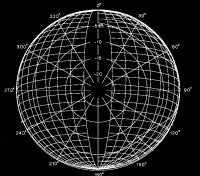 ttern on all four axes (0°, 90°, 180°, and 270°). ttern on all four axes (0°, 90°, 180°, and 270°).
Omni-directional microphones pick up sound from all directions equally as can be seen from the polar response. They tend to produce the most natural sound of all the pickup patterns, capturing the sound source plus all the other acoustic reverberations and nuances. They are also not suscetible to the Proximity Effect as are Cardioids. As such, they are used mainly for recording work. Omni's are not normally used for live work as they would pick up unwanted sounds such as the audience and sound from speakers, creating one horrendous feedback problem
.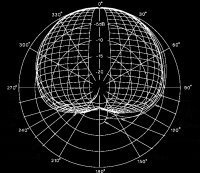
With a Cardioid pattern (the name coming from the heart shape of the pattern) the vast majority of the sound is picked up from the front of the microphone with a reasonable amount from the sides. Very little, however, is picked up from behind. As a result, you can point this mic at the sound you want to pick up. This is probably the most commonly used pattern you will come across as it is very versatile and can be used in practically all situations.
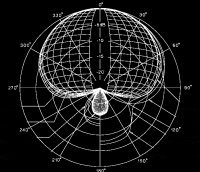
Hyper-Cardioid microphones have a similar pattern to cardioid but the response from the sides (referred to as off-axis) is less. This makes it more directional than the Cardioid. Hyper cardioid microphones are used when isolation between sound sources is important. They are less sensitive to off-axis sounds and will not pick up near-by sources as easily. Another common use is when used live and there is a feedback problem. Hyper-Cardioid microphones are less likely to pick up sound spill from speakers due to their more directional nature and thus reduce the chances of feedback occuring.
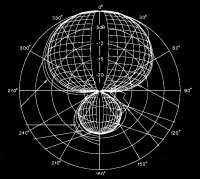 Shotgun microphones have a very tight pickup pattern and are highly directional. They are used primarily to pick up sounds from a distance. Common uses are in broadcast/film recording work where the mic can be held or suspended 'off-camera' and in the theatre for picking up actors on stage without having to individually mic them all. Due to the sensitivity of these microphones, they are all condensers and, as such, require a phantom power supply. Shotgun microphones have a very tight pickup pattern and are highly directional. They are used primarily to pick up sounds from a distance. Common uses are in broadcast/film recording work where the mic can be held or suspended 'off-camera' and in the theatre for picking up actors on stage without having to individually mic them all. Due to the sensitivity of these microphones, they are all condensers and, as such, require a phantom power supply.
 Figure-of-8 microphones again tend to find their use for recording work, picking up sound from the front and rear of the mic but not from the sides. Often used when making stereo recordings. Figure-of-8 microphones again tend to find their use for recording work, picking up sound from the front and rear of the mic but not from the sides. Often used when making stereo recordings.
Frequency Response
The frequency response shows how a microphone responds to sound on different frequencies. A particular microphone may boost or cut the level of a particular frequency. Ideally, the frequency response should be a flat line, which would result in an exact capture of the sound source. However, in real life the frequency response does vary which leads to the captured sound being 'coloured' by the microphone itself.

You will tend to find that only the more expensive microphones exhibit a flatter response. At the end of the day, you pay for what you get. However, there are times when you want the sound to be 'coloured' in a particular way. In fact, certain microphones are deliberately designed with a non-linear frequency response. These tend to be aimed at recording a certain type of sound, e.g. the human voice, where a boost or cut to a range of frequencies actually helps the sound.
Proximity Effect
The Proximity Effect is a characteristic of Cardioid microphones where, as the sound source gets close to the capsule, the low frequency response increases. This can produce a rich, warm sound if used correctly. Radio broadcasters use this effect to give their voices a pleasant warmth. This effect does not exist in Omni-directional microphones.
Phantom power
Phantom power refers to a powering system used for microphones that require an external power supply, such as condenser microphones. Some condenser microphones have built-in battery packs either in the microphone itself or at the connector end; these microphones can usually accept phantom power in addition to the battery pack. Most mixing desks will supply phantom power of 48v DC, although the microphones themselves can usually accept anywhere from 1.5v DC to 50v DC-- but check with the microphone in question to be sure.
Maximum SPL is a specification that defines the level of the loudest sound the microphone can handle without becoming overloaded, resulting usually in some sort of distortion. It is important to note that the microphone capsule is often blamed for distortion in a sound system when in fact the microphone is overloading the preamplifier stage to which it is connected. A professional microphone should be able to handle sound pressure levels of at least 130 dB SPL without overloading the capsule-- that is the threshold of pain: very, very loud. The peak level from a well-trained rock vocalists may approach 130 dB SPL; however, when close-micing percussive instruments, sound levels may approach 140 dB SPL, so a microphone capable of withstanding 150 dB SPL or more should be chosen. Note that when using condenser microphones, the overload point will be decreased if a lower phantom power voltage is applied; if your battery-powered condenser microphone becomes distorted for no apparent reason, replace the battery.
GAIN!
Gain in a sound system is the amount of amplification or additional level obtainable in a sound system, quantifiable in decibels or as power or voltage ratios. Proper system structure, proper microphone placement, and proper loudspeaker placement will all help to maximise a sound system's acoustic gain. Briefly, when dealing with microphone-cum-loudspeaker placement, we should keep the distance between the microphone and the loudspeaker as large as is humanly possible, keep the distance between the microphone and the sound source as small as possible, and use directional microphones and loudspeakers, well-placed so the interaction between the two is minimised.
It is logical that as one adds microphones to a sound system, the potential acoustic gain will decrease. When quantified, every time you double the number of open microphones (i.e. microphones that are on), the system gain is 3dB closer to feedback. When operating a sound system, then, it is important that only those microphones that are required be turned on, and those that are not required are turned off. Additionally, while it can sometimes benefit a sound recording by using eight microphones on the drumkit, it may be necessary that only three are needed in a reinforcement situation.
Good microphone placement when micing musical instruments will help increase a system's overall gain. While in recording work, it is often desired to capture room "ambience" and all sorts of good psychoacoustic phenomena within a room, in live work it is desirable to close mic instruments as much as possible. When a close-micing technique is used, the microphone "hears" a higher acoustic sound pressure level, which translates into a higher voltage, which provides for a cleaner signal at the mixing desk, and consequently through the rest of the system. Ambient noise pickup is reduced in a close-micing situation, which provides for better gain-before-feedback.
When micing vocalists, it is important that the designer or operator educate the uneducated in proper microphone technique. Public speakers or vocalists who "eat" the microphone, stand three feet away from the microphone, or nervously shift from side-to-side are big culprits; for the stubborn, the only solution may be to use a lavalier microphone, which, while providing less-than-optimal system gain, at least travels with the talent as he or she wanders further and further away from the lectern.
Examples of Microphone Choice
Here are a number of commonly used microphones are suggested uses. Don't be afraid to experiment, though, and break from the norm. Sometimes this is necessary when you have a limited number of microphone to play with for an event.
Shure SM58
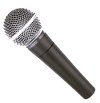 Let's start with probably the best known microphone in the business. The legendary Shure SM58 is a dynamic microphone which is great all-rounder. It is primarily used for vocals and is a favourite with touring bands due to its ability to withstand abuse. However, it is always a good chioce for a spare mic as it can be used in virtually any situation. Common Uses - Vocals, Brass, Drums Let's start with probably the best known microphone in the business. The legendary Shure SM58 is a dynamic microphone which is great all-rounder. It is primarily used for vocals and is a favourite with touring bands due to its ability to withstand abuse. However, it is always a good chioce for a spare mic as it can be used in virtually any situation. Common Uses - Vocals, Brass, Drums
S hure Beta58A hure Beta58A
The enhanced version of the classic SM58 microphone. This microphone features a Hyper-Cardioid polar response and an increased output. Designed specifically as a vocal microphone, it is favoured by vocalists who need a smoother response than the SM58 and by those who need a mic with a greater amount of gain before feedback. Common Uses - Vocals
Shure SM57
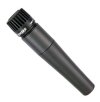 Another classic microphone from Shure. The '57 is a favourite for live music working on drums and guitar cabinets. On snare drums, some engineers will use two mics - one on the top skin to capture the 'snap' and one underneath so the 'sizzle' of the snare can also be heard in the mix. Built with the same durability as its sister the SM58. Common Uses - Guitar Amps, Snare Drums, Rack/Floor Toms, Percussion Another classic microphone from Shure. The '57 is a favourite for live music working on drums and guitar cabinets. On snare drums, some engineers will use two mics - one on the top skin to capture the 'snap' and one underneath so the 'sizzle' of the snare can also be heard in the mix. Built with the same durability as its sister the SM58. Common Uses - Guitar Amps, Snare Drums, Rack/Floor Toms, Percussion
Shure Beta57A
 The enhanced version of the SM57 microphone. Again, like most of the Beta series, this microphone features a Hyper-Cardioid polar response and an increased output. Designed as an instrument microphone, it is found commonly on drum kits, especially around the snare and on guitar cabinets. It is also favoured by some vocalists - especially for rock vocals where its punchy sound works well. Common Uses - Guitar Amps, Snare Drums, Vocals The enhanced version of the SM57 microphone. Again, like most of the Beta series, this microphone features a Hyper-Cardioid polar response and an increased output. Designed as an instrument microphone, it is found commonly on drum kits, especially around the snare and on guitar cabinets. It is also favoured by some vocalists - especially for rock vocals where its punchy sound works well. Common Uses - Guitar Amps, Snare Drums, Vocals
Shure Beta52
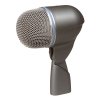 A dedicated kick-drum microphone. This model features an enhanced bass response and an ability to handle very high SPL's. This makes it ideal for use inside a bass drum where most microphones would start to distort. Also used to mic up bass guitar cabinets. Common Uses - Kick Drums, , Bass Guitar A dedicated kick-drum microphone. This model features an enhanced bass response and an ability to handle very high SPL's. This makes it ideal for use inside a bass drum where most microphones would start to distort. Also used to mic up bass guitar cabinets. Common Uses - Kick Drums, , Bass Guitar
AKG C391
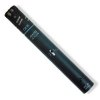 The C391 is a modular condenser microphone. It is comprised of a powering module (the SE300) and interchangable capsules. This means that simply by changing the capsule you can change the polar pattern. The CK91 capsule that is fitted in this case is a cardioid capsule. The quality of the sound is very high due to this microphone being a condenser and will find many uses. For vocal work it is very good at capturing sounds from a short distance. It is not, however, used for vocals in rock music or similar as the singer normally gets right up to the mic and the SPL (Sound Pressure Level) would be too high for the capsule causing it to overload and distort. Common Uses - Choirs, Lecterns, Accoustic Instruments, Hi-hats, Cymbals, Percussion The C391 is a modular condenser microphone. It is comprised of a powering module (the SE300) and interchangable capsules. This means that simply by changing the capsule you can change the polar pattern. The CK91 capsule that is fitted in this case is a cardioid capsule. The quality of the sound is very high due to this microphone being a condenser and will find many uses. For vocal work it is very good at capturing sounds from a short distance. It is not, however, used for vocals in rock music or similar as the singer normally gets right up to the mic and the SPL (Sound Pressure Level) would be too high for the capsule causing it to overload and distort. Common Uses - Choirs, Lecterns, Accoustic Instruments, Hi-hats, Cymbals, Percussion
AKG C392
This Omni-Directional microphone is great for use in orchestral or choral recording work. It is the SE300B fitted with the CK92 Omni-directional capsule. Best used as a pair in a stereo A-B configuration and placed where the audience would sit. These will then pick up the full orchestra/choir sound plus the surrounding room acoustics too making a natural stereo recording. Common Uses - Recording
AKG D112
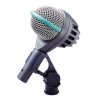 The D112 is the latest incarnation of a classic AKG mic purposefully designed to live in one of the most demanding environments - inside a kick drum! Its oval shape has gained it the name "the egg" and is still held in great respect by many sound engineers around the world. It has a very good low frequency response and can withstand a very high SPL (Sound Pressure Level). This makes it ideal for work with drums (mainly the kick) but can be used with other low frequency sources. Common Uses - Kick Drums, Double Bass, Cello, Bass Guitar Amps The D112 is the latest incarnation of a classic AKG mic purposefully designed to live in one of the most demanding environments - inside a kick drum! Its oval shape has gained it the name "the egg" and is still held in great respect by many sound engineers around the world. It has a very good low frequency response and can withstand a very high SPL (Sound Pressure Level). This makes it ideal for work with drums (mainly the kick) but can be used with other low frequency sources. Common Uses - Kick Drums, Double Bass, Cello, Bass Guitar Amps
Sennheiser E604
 A rather clever little microphone from Sennheiser. This microphone was specifically designed for percussion work and comes supplied with a rather nifty clip which attaches to most drum rims. It can also be attached to standard microphone stands. Its small design, coupled with a good SPL performance enables it to capture percussive sounds well. Usually used to mic up the toms on a standard kit. Common Uses - Rack/Floor Toms, Snare Drums, Bongos/Congas A rather clever little microphone from Sennheiser. This microphone was specifically designed for percussion work and comes supplied with a rather nifty clip which attaches to most drum rims. It can also be attached to standard microphone stands. Its small design, coupled with a good SPL performance enables it to capture percussive sounds well. Usually used to mic up the toms on a standard kit. Common Uses - Rack/Floor Toms, Snare Drums, Bongos/Congas
Sennheiser K6/ME66
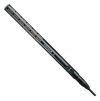 Another modular microphone system this time featuring the K6 powering module and Sennheiser's ME66 Short-Shotgun capsule. This super-cardioid design will pick up sound from a distance while minimising the off-axis sound. Used primarily in live recording and theatre work. Common Uses - Television, Film,Theatre. Another modular microphone system this time featuring the K6 powering module and Sennheiser's ME66 Short-Shotgun capsule. This super-cardioid design will pick up sound from a distance while minimising the off-axis sound. Used primarily in live recording and theatre work. Common Uses - Television, Film,Theatre.
|